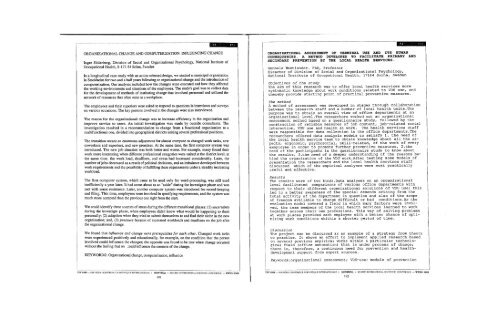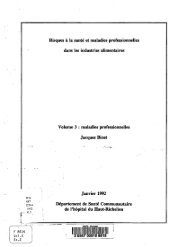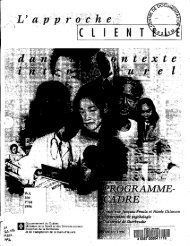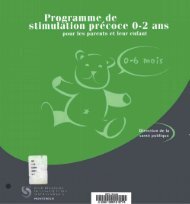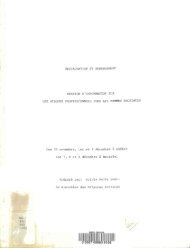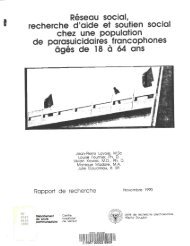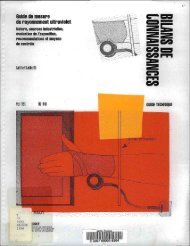le travail à l'écran de visualisation work with display units
le travail à l'écran de visualisation work with display units
le travail à l'écran de visualisation work with display units
Create successful ePaper yourself
Turn your PDF publications into a flip-book with our unique Google optimized e-Paper software.
ORGANIZATIONAL CHANGE AND COMPUTERIZATION: INFLUENCING CHANGEInger Sô<strong>de</strong>rberg, Division of Social and Organizational Psychology, National Institute ofOccupational Health, S-171 84 Solna, Swe<strong>de</strong>nIn a longitudinal case study <strong>with</strong> an action oriented <strong>de</strong>sign, we studied a municipal organizationin Stockholm for two and a half years following an organizational change and the introduction ofcomputerization. Our analysis inclu<strong>de</strong>d how the changes were executed and how they affectedthe <strong>work</strong>ing environments and situations of the employees. The study's goal was to col<strong>le</strong>ct datafor the <strong>de</strong>velopment of methods of instituting change that involved personnel and utilized thenet<strong>work</strong> of resources that often exist at a <strong>work</strong>place.The employees and their superiors were asked to respond to questions in interviews and surveyson various occasions. The key persons involved in the changes were also interviewed.The reason for the organizational change was to increase efficiency in the organization andimprove service to users. An initial investigation was ma<strong>de</strong> by outsi<strong>de</strong> consultants. Theinvestigation resulted in a recommendation to change from a functional organization to amultifunctional one, divi<strong>de</strong>d into geographical districts uniting several professional positions.The transition meant an enormous adjustment for almost everyone to changed <strong>work</strong> tasks, newco<strong>work</strong>ers and superiors, and new premises. At the same time, the first computer system wasintroduced. The new job situation was both better and worse. For examp<strong>le</strong>, many found their<strong>work</strong> more interesting when different professional categories were united at the district <strong>le</strong>vel; atthe same time, the <strong>work</strong> load, <strong>de</strong>adlines, and stress had increased consi<strong>de</strong>rably. Later, thenumber of jobs <strong>de</strong>creased as a result of political <strong>de</strong>cisions, and an imbalance <strong>de</strong>veloped between<strong>work</strong> requirements and the possibility of fulfilling these requirements un<strong>de</strong>r a steadily increasing<strong>work</strong>load.The first computer system, which came to be used only for word-processing, was still usedinefficiently a year later. It had come about as an "asi<strong>de</strong>" during the investigate phase and wasmet <strong>with</strong> some resistance. Later, another computer system was introduced for record-keepingand filing. This time, employees were involved in specifying requirements, and the system wasmuch more accepted than the previous one right from the start.We could i<strong>de</strong>ntify three sources of stress during the different transitional phases: (1) uncertaintyduring the investigte phase, when employees didn't know what would be happening to thempersonally; (2) adaption when they tried to submit themselves to and find their niche in the neworganization; and, (3) pressure because of increased <strong>work</strong>loads and <strong>de</strong>adlines on the job afterthe organizational change.We found that influence and change were prerequisites for each other. Changed <strong>work</strong> taskswere experienced positively and educationally, for examp<strong>le</strong>, on the condition that the personinvolved could influence the changes; the opposite was found to be true when change occurred<strong>with</strong>out the feeling that on could influence the contents of the change.KEYWORDS: Organizational change, computerization, influenceORGANIZATIONAL ASSESSMENT OF TERMINAL USE AND ITS HUMANCONSEQUENCES. A METHOD DEVELOPED TO FACILITATE PRIMARY ANDSECONDARY PREVENTION BY THE LOCAL HEALTH SERVICES.Gunnela Westlan<strong>de</strong>r. PhD, ProfessorDirector of Division of Social and Organizational Psychology,National Institute of Occupational Health. 17184 Solna, Swe<strong>de</strong>nObjectives of the studyThe aim of this research was to offer local health services moresystematic know<strong>le</strong>dge about <strong>work</strong> conditions related to VDU use, andthereby provi<strong>de</strong> starting point of practical preventive measures.The methodA method of assessment was <strong>de</strong>veloped in stages through collaborationbetween the research staff and a number of local health <strong>units</strong>.Thepurpose was to obtain an overall view of office <strong>de</strong>partments at anorganizational <strong>le</strong>vel.The researchers <strong>work</strong>ed out an organizationalassessment method based on a questionnaire study, followed by the ^construction of reliab<strong>le</strong> measures of job content, job-related socialinteraction, VDU use and health at <strong>work</strong>. The health services staffwere responsib<strong>le</strong> for data col<strong>le</strong>ction in the office <strong>de</strong>partments. Theresearchers offered data analysis mo<strong>de</strong>ls to satisfy 1. the need ofthe local health service team to obtain know<strong>le</strong>dge about all the aspects,ergonomie, psychosocial, skill-related, of the <strong>work</strong> of everyexmployee in or<strong>de</strong>r to promote further preventive measures, 2.theneed of the participants in the questionnaire study to know aboutthe results, 3.the need of a <strong>de</strong>eper un<strong>de</strong>rstanding of the reasons behindthe organization of the VDU <strong>work</strong>.After testing some mo<strong>de</strong>ls ofpresentation the researchers and the local health services staffdiscussed which of the empirical analyses were most practicallyuseful and effective.ResultsThe results were of two kinds.Data analyses on an organizational<strong>le</strong>vel facilitated comparisons of various office <strong>de</strong>partments <strong>with</strong>respect to their different organizational solutions of VDU use; this<strong>le</strong>d to a better awareness of the special <strong>de</strong>mands arising from thetotal activity of the <strong>de</strong>partment in question and also of the scopeof freedom availab<strong>le</strong> to change difficult or bad conditions .As theevaluation mo<strong>de</strong>l covered a field in which many factors were involved,the team members of the local health services <strong>le</strong>arned to <strong>work</strong>together across their own professions. This way of solving prob<strong>le</strong>msat <strong>work</strong> places provi<strong>de</strong>d each employee <strong>with</strong> a better chance of optimizing<strong>work</strong> conditions whithin a shorter period of time.DiscussionThe project can be discussed as an examp<strong>le</strong> of a strategy from theoryto practice. It shows an effort to imp<strong>le</strong>ment applied research basedon several previous empirical <strong>work</strong>s <strong>with</strong>in a particular technologicalfield (office automation) that is un<strong>de</strong>r process of change;there is, therefore, a continuous need for prevention and health<strong>de</strong>velopmentsupport from expert sources.Keywords:organizationalassessment; VDU-use; mo<strong>de</strong>ls of preventionTEV 1989 — DEUXIÈME CONFÉRENCE SCIENTIFIQUE INTERNATIONALE • MONTRÉAL • SECOND INTERNATIONAL SCIENTIFIC CONFERENCE — WDU 1989192TEV 1989 — DEUXIÈME CONFÉRENCE SCIENTIFIQUE INTERNATIONALE • MONTREAL • SECOND IN'ITiRNATIONAI. SCIENTIFIC CONFERENCE — WWDU 1989193


